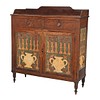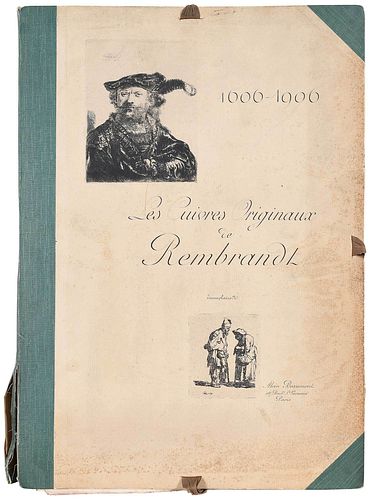Rare Edition, "Les Cuivres de Rembrandt"
Bid Increments
| Price | Bid Increment |
|---|---|
| $0 | $25 |
| $100 | $50 |
| $1,000 | $100 |
| $2,000 | $200 |
| $3,000 | $250 |
| $5,000 | $500 |
| $10,000 | $1,000 |
| $20,000 | $2,000 |
| $50,000 | $5,000 |
| $100,000 | $10,000 |
Les Cuivres de Rembrandt, R‚impression des Planches Originales, complete set of 80 etchings, 78 by Rembrandt, one etching by Ferdinand Bol (No. 272), one etched copy after Rembrandt (No. 200), Alvin Beaumont and Michel Bernard, editors, Paris, 1906, Imprimerie Chaponet, printer, cloth and paper portfolio. approximate size 17-3/4 x 12-3/4 x 2 in.
Provenance: Robert Lee Humber and Lucie Bertier Humber, North Carolina; John L. Humber and Jean L. Humber, North Carolina
Note: This volume was acquired by Robert Lee Humber while he was living in Paris, France, circa 1920-1940. In 1938, Humber purchased Rembrandt?s original plates from his friend, Alvin Beaumont. According to various sources, prior to Humber?s ownership,?Rembrandt?s copper plates were on loan to the Rijksmuseum in Amsterdam for seven years during which time Beaumont attempted to negotiate the sale of the plates to the Rijksmuseum. Beaumont also offered Rembrandt?s copper plates to the British Museum of Art, but he was unable to reach an agreement with either of these museums.? When Humber returned to North Carolina, the plates were stored and some exhibited by the North Carolina Museum of Art in Raleigh from the 1960s to 1993, when the heirs decided to sell the plates. The plates were separated for the first time and sold to a large number of private collectors, dealers, and museums, including six Dutch museums and the BibliothŠque Nationale in Paris. Eight plates remain on exhibit at the North Carolina Museum of Art, a museum Robert Lee Humber was instrumental in establishing. The history of ownership of Rembrandt's plates began in the 17th century with the artist?s friend, Clement de Jonghe. Ownership changed hands until they were purchased by Claude Henri Watelet in the late 18th century. Watelet was the first to print from these plates and these impressions are considered desirable to collectors. In the early 19th century, Henri Louis Basan purchased the plates and began the practice of printing what is called ?recueils?, complete editions from the intact collection of plates.These plates were printed on demand by the Basan family and by subsequent owners into the early 20th century. In 1906, the final "recueil" was printed from Rembrandt's surviving original copper etching plates by Alvin Beaumont and Michel Bernard. These volumes, in either the 19th century or the early 20th century editions, are extraordinarily rare to find intact or even mostly intact. It is certain that many of these volumes were broken and the etchings were sold separately in the market. Only three of the Chaponet edition, or the ?last recueil? can be found in libraries., the RKD, the British Library, and Bibliothèque Diderot in Lyon, France.It is extraordinary to have this volume completely intact and from the last owner of Rembrandt?s original plates.For one other example of this rare portfolio see: https://catalogue.swanngalleries.com/Lots/auction-lot/REMBRANDT-VAN-RIJN-Les-Cuivres-de-Rembrandt-R%C3%A9impression-des?saleno=2429&lotNo=193&refNo=725906
Condition
mounts and text sheets with toning, chipping on 1906 table, pencil inscriptions, some creases and folds, small tears, some old, small clips holding text and mounts together; portfolio with tears, handling grime
Purchased items will be available for pick up or shipping from our Asheville, North Carolina auction facility within ten business days of the auction will be assessed a storage fee of $5.00 per day, per item. Purchaser agrees that packing and shipping is done at the purchaser's risk and that the purchaser will pay in advance all packing expenses, materials, carrier fees and insurance charges. At our discretion, items will either be packed by an agent such as a packaging store or Brunk Auctions. Please allow two weeks for shipping after payment is received. Shipment of large items is the responsibility of the purchaser. We are happy to provide names of carriers and shippers if a purchaser so requests. Brunk Auctions will have no liability for any loss or damage to shipped items.













































